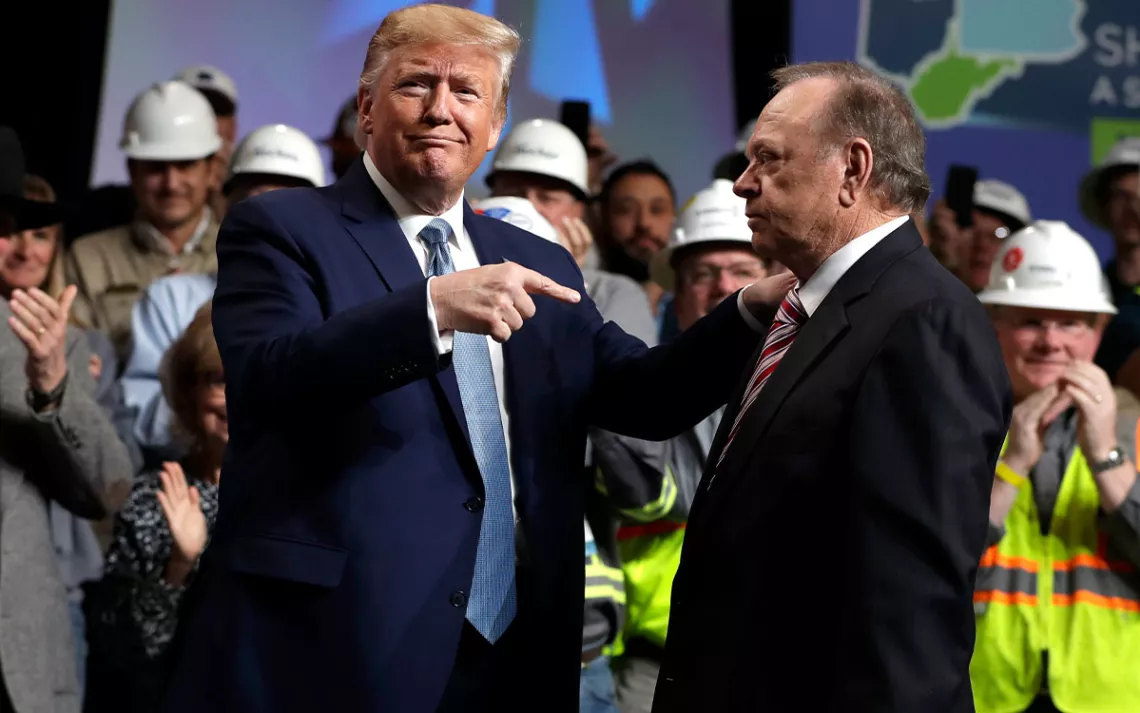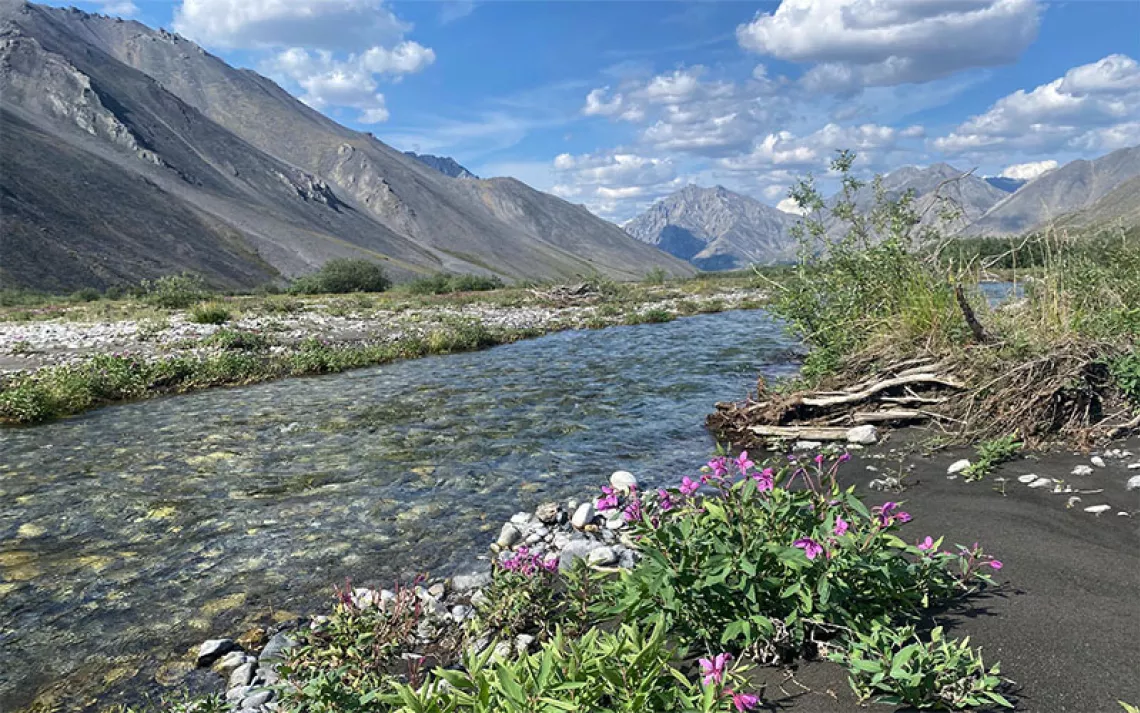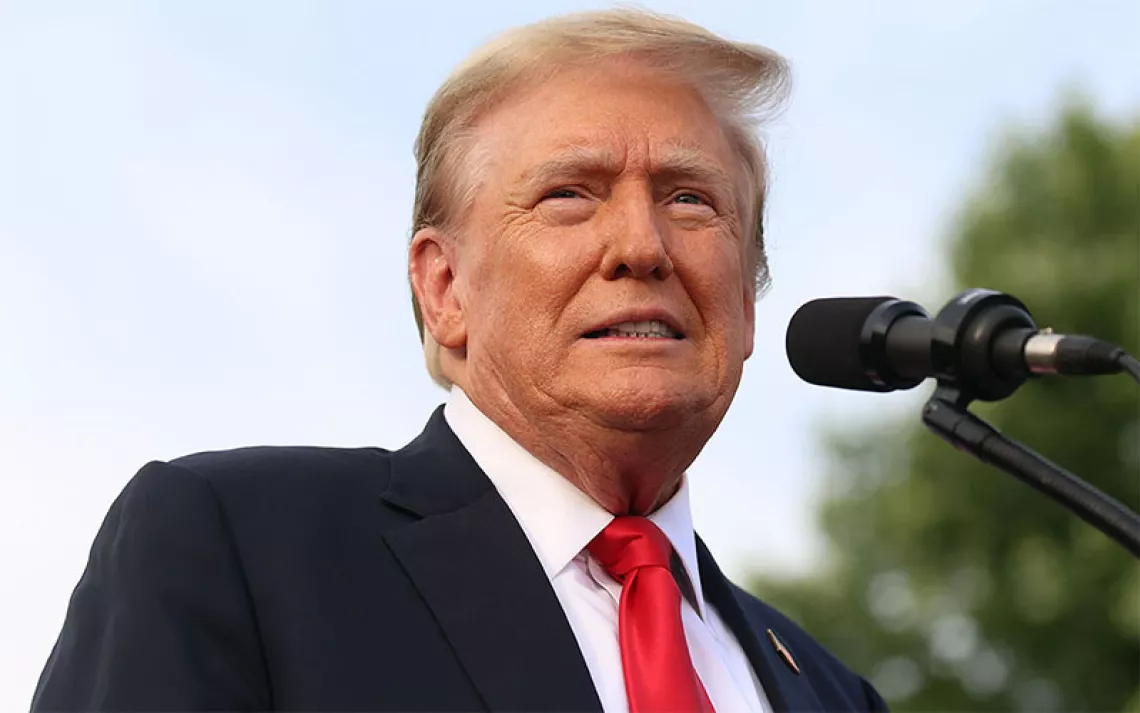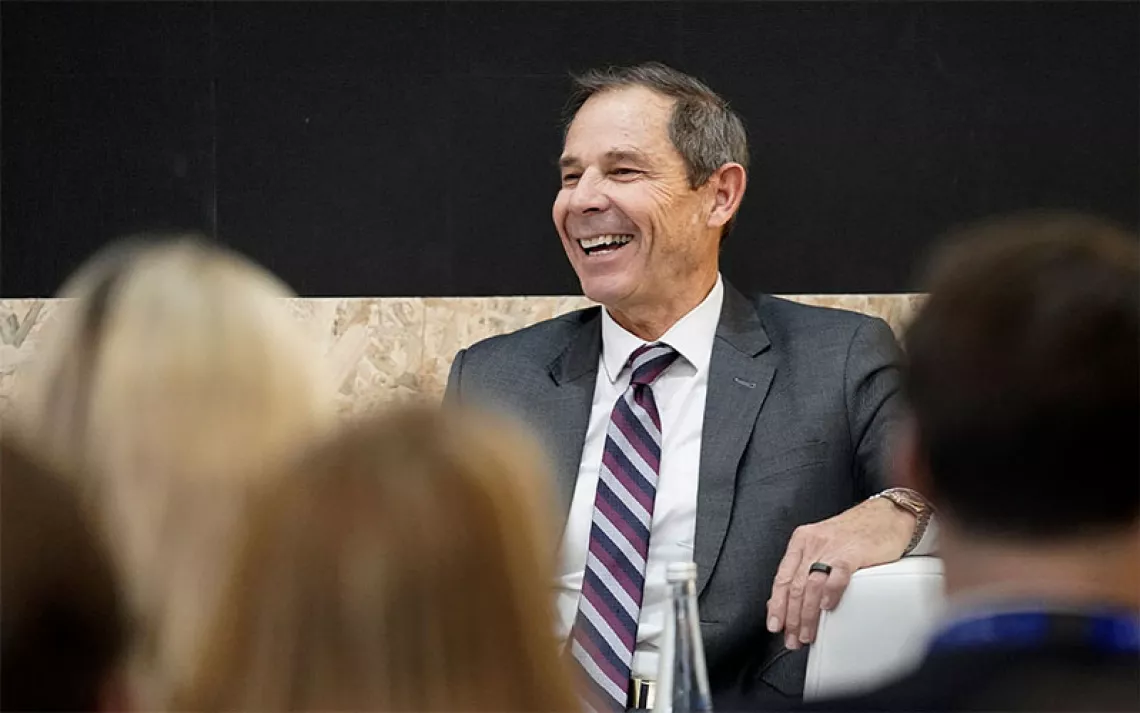Oil Tycoons Open the Money Floodgates for Trump
Fossil fuel giants are all in to help elect Trump

Former president Donald Trump gestures to Harold Hamm, CEO and majority owner of North Dakota’s largest oil company, Continental Resources, in 2019. | Photo by Evan Vucci/AP
Back in the early days of 2023, Harold Hamm believed that former South Carolina governor Nikki Haley might have a shot at beating former president Donald Trump in the Republican primary contest. And so Hamm, a billionaire oilman from Oklahoma, invested $21,600 in Haley’s two Stand for America Political Action Committees, and the maximum $6,600 to Haley’s campaign itself over the course of two quarters. He gave similar amounts to Florida governor Ron DeSantis’s presidential campaign, and, in an interview with the Financial Times, urged Trump to drop out and become a kingmaker.
For Hamm, a pioneer in fracking for shale oil and horizontal drilling, the defection was dramatic. In the 2016 campaign, Hamm had effectively written Trump’s energy policy speeches; Politico called him “Trump’s energy whisperer.” In 2020, Hamm had his eye on a cabinet post in the Energy Department or Interior Department; he’d even been spotted wearing a Trump-branded tie. But after the January 6 insurrection, Hamm and many other oil and gas executives had lost faith that the already indicted real estate mogul would have the influence to roll back the regulations thwarting their success. Worse, Hamm was no longer persuaded that Trump could beat a Democrat.
One year later, Hamm was once again showering the now-indicted felon running for president with cash wherever he could. In April of this year, Hamm co-chaired a fundraiser at the Palm Beach, Florida, home of billionaire investor John Paulson, a privilege for which he paid $824,000. That same month, The Washington Post reported, Hamm helped put together the now-notorious chopped-steak dinner for oil executives at Mar-a-Lago during which Trump promised to fast-track drilling permits, eliminate tailpipe emission standards, and unfreeze permits for liquefied natural gas terminals, all for the cool price of a $1 billion donation.
It was an unusually frank pitch even for Trump, and it may even have been illegal. “There's a bribery statute that bars any public official from seeking or accepting anything of value in exchange for an official act,” says Virginia Canter, chief ethics counsel for the nonpartisan Citizens for Responsibility and Ethics in Washington (CREW). When The Washington Post reported that Trump had promised day-one actions in exchange for a hefty donation, CREW filed a complaint with the FBI and the Justice Department, asserting that the former president had violated that statute. “The industry had been reluctant to contribute to Trump's presidential campaign because he didn't really effectively deliver in his last term,” Canter notes. This time around, “they’re drafting executive orders” in advance of the election.
Hamm in late May held a luncheon for Trump in Houston to make sure Trump understood the oil and gas industry’s message. In attendance were Occidental Petroleum president Vicki Hollub and Energy Transfer chairman Kelcy Warren, who once remarked that Dakota Pipeline protesters needed to be “removed from the gene pool.” (One of the first actions Trump took after taking office in 2017 was to approve Warren’s Dakota Access Pipeline.)
Fossil fuel magnates have long wielded influence over elected officials, but since the Supreme Court’s Citizens United decision in 2010 classified political donations as “free speech”—and thus lifted restraints on them—the oil and gas industry’s donations have increased dramatically. In 2010, oil and gas companies gave around $35 million to all candidates combined; by 2018, that number had risen to $84 million. With rare exceptions for certain Democrats in states where oil has political influence—Texas and California, for instance—almost all that money went to Republican candidates, whose values already align with those of the drillers.
In the 2024 campaign cycle, oil and gas interests, Hamm among them, have already contributed close to $80 million to political campaigns, according to the Center for Responsive Politics; donations to Republicans outpace those to Democrats more than three to one. Oil and gas companies and their top executives have given $13.7 million to Trump. By contrast, the Biden and now Harris campaign has netted $726,000. In the simplest terms, oil and gas interests have donated roughly $18 to Trump for every $1 donated to the Democratic nominee.
The knowledge that a candidate has dirty energy’s support will no doubt alienate some parts of the electorate, says Jenny Rowland-Shea, public lands director at the Center for American Progress. “Voters really don’t trust oil and gas CEOs,” she says. “They blame high energy prices on large oil companies, believe these companies have too much power in government, and have seen the industry standing against Americans' best interests.”
But money still talks. “The oil industry may not have much influence over voters,” Rowland-Shea says, “but its deep pocketbooks certainly influence politicians.”
One particularly glaring irony is that the cash Big Oil is donating to Trump and his affiliated PACs comes from oil-industry profits, which over the past three years, under a Democratic president, have enjoyed a period of jaw-dropping bounty. In 2023, the United States “produced more oil than any country, ever,” according to the US Energy Information Administration. Profits in the last three years have jumped nearly 200 percent. According to Moody’s, the “Big Five” (BP, Chevron, ExxonMobil, Shell, and Total Energies) “generated $613 billion” between January 2021 and September 2023.
Some climate advocates criticize the Biden administration for not being aggressive enough at reducing oil and gas supplies, and declining to issue executive orders that would reduce US greenhouse gas pollution. In 2023, yet another warmest year on record, the administration gave the go-ahead to the Willow Project, ConocoPhillips’s boondoggle of a drilling project in the National Petroleum Reserve, where 600 million barrels of oil lie beneath a permafrost grown so spongy with warmth that it has to be chilled before it can be drilled.
But it’s also true, of course, that the current administration has taken more action on climate than any federal government in history, and has instituted more than 100 policies protecting the environment over the course of the Biden–Harris tenure. The administration has overturned 98 of Trump’s anti-environmental policies, including the approval of the Keystone XL Pipeline. Trump, on the other hand, has pledged fealty to a climate-destroying industry and will likely make good on his promises.
"The fossil fuel industry knows a second Trump presidency would give them full control of all public lands and lock in decades more oil and gas extraction even if it destroys our climate," said Brett Hartl of the Center for Biological Diversity Action Fund. "Trump unleashed nearly unprecedented fossil fuel extraction, and now he is promising to be a dictator on day one to drill, drill, drill.”
Paid for by the Sierra Club Voter Education Fund, which seeks to raise key environmental issues in the discussions around elections and encourage the public to find out more about candidates’ positions on key environmental issues.
 The Magazine of The Sierra Club
The Magazine of The Sierra Club



